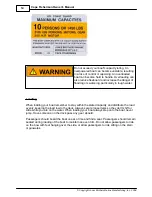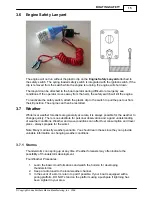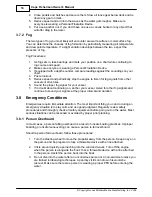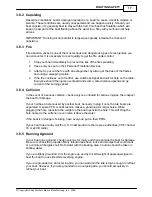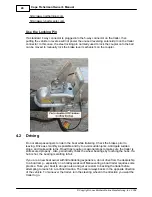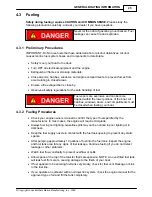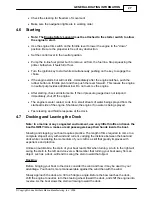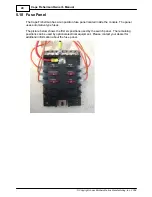
GENERAL BOATING INFORMATION
27
© Copyright Jones Brothers Marine Manufacturing, Inc. 2008
·
Check the steering for freedom of movement
·
Make sure the navigation lights are in working order
4.6
Starting
·
Note: The Engine Safety Lanyard must be attached to the starter switch to allow
the engine to start.
·
Use the engine trim switch on the throttle lever to lower the engine to the "down"
position. Be sure the propeller is free of any obstruction.
·
Set the control lever in the neutral position.
·
Pump the in-line fuel primer bulb to remove air from the fuel line. Stop squeezing the
primer bulb when it feels full of fuel.
·
Turn the ignition key to start while simultaneously pushing on the key to engage the
choke.
·
If the engine starts but will not idle - Immediately after the engine catches, push the
rubber button on throttle pivot and then push the lever forward. This leaves the engine
in neutral put provides additional fuel. Do not over-rev the engine
·
After starting, check all instruments. If the oil pressure gauge does not respond
immediately, shut off the engine.
·
The engine is water cooled. Look for a small stream of water being sprayed from the
starboard side of the engine. Shutdown the engine if no water is being sprayed.
·
Test steering and throttle response at the dock.
4.7
Docking and Leaving the Dock
Note: In a marina or any congested environment, use very little throttle and move the
boat SLOWLY! Also, make sure all passengers keep their hands inside the boat.
Slowing and stopping your boat requires practice. The length of time required to come to a
complete stop will vary with wind and current. Judging the distance between the boat and
dock while considering the momentum of your craft is a skill that greatly improves with
experience and practice.
Unlike an automobile, the stern of your boat reacts first when turning. A turn to the right will
swing the stern to the left and vice-versa. Remember that turning your boat away from an
object, such as a dock, will tend to swing the stern toward that object.
Docking
Before bringing your boat to the dock, consider the wind and how it may be used to your
advantage. Your boat is more maneuverable against the wind than with the wind.
Slowly approach the dock at a 30 to 45 degree angle. Before the bow reaches the dock,
shift the engine to neutral, turn the steering wheel toward the dock, and shift the engine into
reverse. As the boat slows the stern will swing toward the dock.
Summary of Contents for Cape Fisherman
Page 1: ...Cape Fisherman Owner s Manual...
Page 6: ......
Page 7: ...WELCOME Part I...
Page 9: ...OVERVIEW Part II...
Page 12: ......
Page 13: ...BOATING SAFETY Part III...
Page 26: ......
Page 27: ...GENERAL BOATING INFORMATION Part IV...
Page 37: ...OPERATION Part V...
Page 55: ...MAINTENANCE AND SERVICE Part VI...


